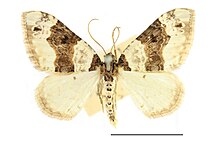| Purple bar | |
|---|---|

| |

| |
| Cosmorhoe ocellata | |
| Conservation status | |
 Least Concern (IUCN 3.1) | |
| Scientific classification | |
| Domain: | Eukaryota |
| Kingdom: | Animalia |
| Phylum: | Arthropoda |
| Class: | Insecta |
| Order: | Lepidoptera |
| Family: | Geometridae |
| Tribe: | Cidariini |
| Genus: | Cosmorhoe Hübner, 1825 |
| Species: | C. ocellata |
| Binomial name | |
| Cosmorhoe ocellata (Linnaeus, 1758) | |
| Synonyms | |
|
Generic
Specific
| |
Cosmorhoe is a monotypic moth genus in the family Geometridae erected by Jacob Hübner in 1825. Its only species, Cosmorhoe ocellata, the purple bar, was described by Carl Linnaeus in his 1758 10th edition of Systema Naturae.
Distribution
The species can be found in the Palearctic realm, which includes western Europe and the British Isles, Central Europe, Central Asia, Asia Minor, and Kyrgyzstan.
Habitat
In the Alps, it can be found at elevations up to 1500 meters. The species is found in many habitats, including heathland, deciduous and mixed forests, forest clearings, bushy places, grasslands, fens, scrub, gardens and park-like landscapes.
Description
Their wingspan is between 20 and 29 mm and the length of their forewings is between 13 and 15 mm. The ground colour of the forewings is creamy white to bright white. The base and midfield are coloured black to blue black. The latter is crossed by two bright lines. In the midfield band is a deep, jagged spot. In the bright areas between the basal area and the midfield as well as in the marginal field are grey or black spots of varying degrees. The hindwings are whitish and show a small black middle spot.

Caterpillars are brownish, with bright angled markings on their backs and bright stripes on the sides. The pupa is usually shiny red brown.
Biology
This species shows two generations in the southern United Kingdom (from May to early July and from August to mid-October), but a single brood further north. The moths fly from May to August in the British Isles, and from mid-April till October in other parts of the range. They are active from dusk onwards. The larvae feed from June to September on various species of bedstraw (mainly Galium mollugo and Galium verum). The larvae hibernates as a full-grown larva. They pupate in a cocoon.
References
- Savela, Markku. "Cosmorhoe Hübner, 1825". Lepidoptera and Some Other Life Forms. Retrieved April 25, 2019.
- Fauna Europaea
- ^ "Suffolk Moths". Archived from the original on 2017-03-25. Retrieved 2019-04-25.
- Butterflies and Moths of Northern Ireland
- Meyrick, E., 1895 A Handbook of British Lepidoptera MacMillan, London pdf
 This article incorporates text from this source, which is in the public domain. Keys and description
This article incorporates text from this source, which is in the public domain. Keys and description
- Prout, L. B. (1912–16). Geometridae. In A. Seitz (ed.) The Macrolepidoptera of the World. The Palaearctic Geometridae, 4. 479 pp. Alfred Kernen, Stuttgart.pdf
- Jaan Viidalepp and Axel Hausmann, 2013 In: Axel Hausmann (Hrsg.): The Geometrid Moths of Europe. 1. Auflage. Volume 3: Larentiinae I. Apollo Books, Stenstrup 2013, ISBN|978-90-04-26097-9
- Lepiforum e.V.
- Kimmo Silvonen Larvae of North-European Lepidoptera Archived 2017-03-25 at the Wayback Machine
- ^ Lepidoptera of Belgium
- Pitkin, Brian & Jenkins, Paul. "Search results Family: Geometridae". Butterflies and Moths of the World. Natural History Museum, London.
- Purple Bar Cosmorhoe ocellata. UKMoths.
External links
- Paolo Mazzei, Daniel Morel, Raniero Panfili Moths and Butterflies of Europe and North Africa
- De Vlinderstichting (in Dutch)
| Taxon identifiers | |
|---|---|
| Cosmorhoe |
|
| Cosmorhoe ocellata |
|